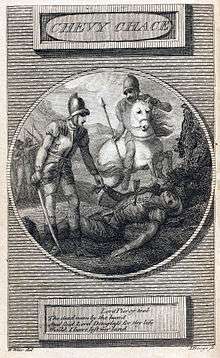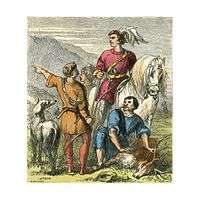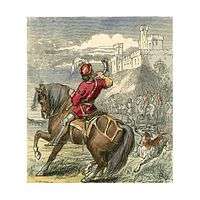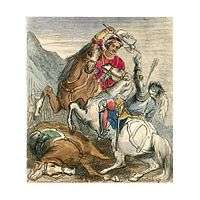The Ballad of Chevy Chase

"The Ballad of Chevy Chase" is an English ballad, catalogued as Child Ballad 162 (Roud 223[1]). There are two extant ballads under this title, both of which narrate the same story. As ballads existed within oral tradition before being written down, other versions of this once popular song also may have existed. Moreover, other ballads used its tune without necessarily referring to "The Ballad of Chevy Chase."
Synopsis



The ballads tell the story of a large hunting party upon a parcel of hunting land (or chase) in the Cheviot Hills (a range of rolling hills straddling the Anglo-Scottish border between Northumberland and the Scottish Borders), hence the term, Chevy Chase. The hunt is led by Percy, the English Earl of Northumberland. The Scottish Earl Douglas had forbidden this hunt and interpreted it as an invasion of Scotland. In response he attacked, causing a bloody battle after which only 110 people survived. Both ballads were collected in Thomas Percy's Reliques and the first of the ballads in Francis James Child's Child Ballads. Different versions were collected in England, Scotland, and the US.[1]
Historical basis
Scholar Francis J. Child as well as Thomas Percy noted similarities between this ballad and the older "The Battle of Otterburn", which refers to the historical Battle of Otterburn in 1388, although neither set of lyrics are completely historically accurate.[2] Versions of either ballad often contain parallel biographical and historical information; nonetheless, the differences led Child to believe that they did not originally refer to the same occurrence.[3]
Simpson suggests that the music of Chevy Chase was identical to the tune of Flying Flame, in which the former superseded the latter by the beginning of the seventeenth century.[4]
Versions of "The Ballad of Chevy Chase" exist in several ballad collections like: the Roxburghe Ballads, the Pepys Library, the Huntington Library Miscellaneous, the Glasgow University Library, and the Crawford Collection at the National Library of Scotland. The ballads in these collections were printed with variations between 1623 and 1760.[5] Online facsimiles of the ballad are also available for public consumption at sites like the English Broadside Ballad Archive.
First ballad
The first of the two ballads of Chevy Chase perhaps was written as early as the 1430s, but the earliest record we have of it is in The Complaynt of Scotland, one of the first printed books from Scotland. The Complaynt of Scotland was printed in around 1550, and in it the ballad is called The Hunting of Cheviot, while the first manuscript version of the ballad was written ca. 1550 (MS Ashmole 48, Bodleian Library)[6]. In the seventeenth century, the tune was licensed in 1624 and again in 1675.[7]
Sir Philip Sidney said of this early ballad:
- "I never Heard the old song of Percie and Douglas, that I found not my heart moved more than with a trumpet" — Defence of Poesy.
Second ballad
In 1711 Joseph Addison wrote in The Spectator,
The old song of "Chevy-Chase" is the favourite ballad of the common people of England, and Ben Jonson used to say he had rather have been the author of it than of all his works. Sir Philip Sidney, in his discourse of Poetry, speaks of it in the following words: "I never heard the old song of Percy and Douglas that I found not my heart more moved than with a trumpet; and yet it is sung by some blind crowder with no rougher voice than rude style, which being so evil apparelled in the dust and cobweb of that uncivil age, what would it work trimmed in the gorgeous eloquence of Pindar?" For my own part, I am so professed an admirer of this antiquated song, that I shall give my reader a critique upon it without any further apology for so doing.[8]
Apparently Addison was unaware that the ballad he then goes on to analyse in detail, was not the same work praised by Sidney and Jonson.[8] The second of the ballads appears to have been written in modernized English shortly after Sidney's comments, perhaps around 1620, and to have become the better-known version.
Cultural references
In Sir Walter Scott's Rob Roy (1817), the main character, Frank, upon seeing the trophies on the walls of Osbaldistone hall, imagines them being from the Chevy chase.
An early and popular painting of 1825–6 by (Sir) Edwin Landseer was entitled The Hunting of Chevy Chase.
In Emily Brontë's Wuthering Heights (1847), before their relationship blossoms, Catherine Heathcliff (née Catherine Linton) scorns Hareton Earnshaw's primitive attempts at reading, saying, “I wish you would repeat Chevy Chase as you did yesterday; it was extremely funny!”[9]
In Elizabeth Gaskell's North and South (1855), on hearing the conversation between Mr. Thornton and her father, Margaret Hale wonders, “How in the world had they got from cog-wheels to Chevy Chase?”[10]
In F. Anstey's Vice Versa (1882), the boys at Dr Grimstone's boarding school are required to play a game called "chevy" (a version of "prisoners' base" or "darebase"), "so called from the engagement famed in ballad and history".[11]
Legacy
A tract of land in British America was named "Cheivy Chace" by 1725, and was eventually developed into the modern affluent areas of Chevy Chase, Maryland, and Chevy Chase, Washington, D.C. A golf club in the Maryland Chevy Chase inspired the name of Chevy Chase, Lexington, Kentucky.
In naming things after elements of local culture, a shopping mall in the Eldon Square Shopping Centre in Newcastle upon Tyne, is named "Chevy Chase" after the ballad.[12]
The ballad inspired the childhood nickname and adult stage name of the American comedian and actor Chevy Chase (born Cornelius Chase, 1943).
The ballad has given the English language the verb to chivvy, meaning to pester or encourage someone to perform a task.[13][14]
Further reading
- Chappell, William (1859). Popular Music of the Olden Time. London: Cramer, Beale, & Chappell.
- Quiller-Couch, Arthur (1910). The Oxford Book of Ballads. Oxford: Clarendon Press.
- Watt, Tessa (1991). Cheap Print and Popular Piety, 1550–1640. Cambridge: Cambridge University Press. ISBN 0521382556.
Notes
- 1 2 See here
- ↑ Child 1962, p. 289-93.
- ↑ Child, Francis James (1962). The English and Scottish Popular Ballads. New York: Cooper Square Publishers. pp. 303–7.
- ↑ Simpson, Claude (1966). The British Broadside Ballad and its Music. New Brunswick, NJ: Rutgers University Press. p. 97.
- ↑ "English Broadside Ballad Archive". University of California, Santa Barbara. Retrieved 11 September 2014.
- ↑ Diana Newton (2006). North-East England, 1569-1625: Governance, Culture and Identity. Boydell Press. p. 144. ISBN 978-1-84383-254-6.
- ↑ Simpson, Claude (1966). The English Broadside Ballad and its Music. Rutgers University Press. p. 99.
- 1 2 The Works of Joseph Addison: Complete in Three Volumes: Embracing the Whole of the "Spectator," &c, Harper & Brothers, 1837, p.117
- ↑ Brontë, Emily: Wuthering Heights, Chapter 31 (Wikisource link)
- ↑ "North and South", Chapter 10 (Wikisource link)
- ↑ Anstey, F. (1981) [1882]. Vice Versa. Harmondsworth: Penguin. pp. 83–4, 165.
- ↑ "Ballad lyrics and MIDI". Retrieved 8 July 2017.
- ↑ "chevy / chivy, n.". Oxford English Dictionary (3rd ed.). Oxford University Press. September 2005. (Subscription or UK public library membership required.)
- ↑ "chivvy". en.oxforddictionaries.com. Retrieved 21 December 2017.
External links
| Wikisource has original text related to this article: |
- Straight Dope Staff Report: Who or what is Chevy Chase?
- Ballad lyrics and MIDI
- Copies of Chevy Chase Ballads at the English Broadside Ballad Archive of UC,Santa Barbara
- Simpson, Claude. The British Broadside Ballad and its Music. Rutgers University Press. p. 97.